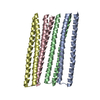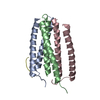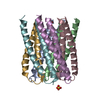+Search query
-Structure paper
| Title | Computational design of transmembrane pores. |
|---|---|
| Journal, issue, pages | Nature, Vol. 585, Issue 7823, Page 129-134, Year 2020 |
| Publish date | Aug 26, 2020 |
 Authors Authors | Chunfu Xu / Peilong Lu / Tamer M Gamal El-Din / Xue Y Pei / Matthew C Johnson / Atsuko Uyeda / Matthew J Bick / Qi Xu / Daohua Jiang / Hua Bai / Gabriella Reggiano / Yang Hsia / T J Brunette / Jiayi Dou / Dan Ma / Eric M Lynch / Scott E Boyken / Po-Ssu Huang / Lance Stewart / Frank DiMaio / Justin M Kollman / Ben F Luisi / Tomoaki Matsuura / William A Catterall / David Baker /     |
| PubMed Abstract | Transmembrane channels and pores have key roles in fundamental biological processes and in biotechnological applications such as DNA nanopore sequencing, resulting in considerable interest in the ...Transmembrane channels and pores have key roles in fundamental biological processes and in biotechnological applications such as DNA nanopore sequencing, resulting in considerable interest in the design of pore-containing proteins. Synthetic amphiphilic peptides have been found to form ion channels, and there have been recent advances in de novo membrane protein design and in redesigning naturally occurring channel-containing proteins. However, the de novo design of stable, well-defined transmembrane protein pores that are capable of conducting ions selectively or are large enough to enable the passage of small-molecule fluorophores remains an outstanding challenge. Here we report the computational design of protein pores formed by two concentric rings of α-helices that are stable and monodisperse in both their water-soluble and their transmembrane forms. Crystal structures of the water-soluble forms of a 12-helical pore and a 16-helical pore closely match the computational design models. Patch-clamp electrophysiology experiments show that, when expressed in insect cells, the transmembrane form of the 12-helix pore enables the passage of ions across the membrane with high selectivity for potassium over sodium; ion passage is blocked by specific chemical modification at the pore entrance. When incorporated into liposomes using in vitro protein synthesis, the transmembrane form of the 16-helix pore-but not the 12-helix pore-enables the passage of biotinylated Alexa Fluor 488. A cryo-electron microscopy structure of the 16-helix transmembrane pore closely matches the design model. The ability to produce structurally and functionally well-defined transmembrane pores opens the door to the creation of designer channels and pores for a wide variety of applications. |
 External links External links |  Nature / Nature /  PubMed:32848250 / PubMed:32848250 /  PubMed Central PubMed Central |
| Methods | EM (single particle) / X-ray diffraction |
| Resolution | 2.4 - 7.6 Å |
| Structure data | EMDB-20613, PDB-6u1s: EMDB-30126, PDB-6m6z:  PDB-6o35:  PDB-6tj1:  PDB-6tms: |
| Chemicals |  ChemComp-HOH:  ChemComp-SO4: |
| Source |
|
 Keywords Keywords |  DE NOVO PROTEIN / nanopore / de novo design / DE NOVO PROTEIN / nanopore / de novo design /  MEMBRANE PROTEIN / MEMBRANE PROTEIN /  Helical bundle / Helical bundle /  octamer / computational design / pore / octamer / computational design / pore /  BIOSYNTHETIC PROTEIN / BIOSYNTHETIC PROTEIN /  hexamer / hexamer /  computational protein design / computational protein design /  Transmembrane / Rosetta Transmembrane / Rosetta |
 Movie
Movie Controller
Controller Structure viewers
Structure viewers About Yorodumi Papers
About Yorodumi Papers








